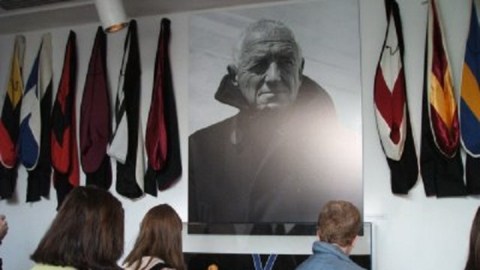The World Behind Wyeth’s Christina’s World

Bought by the MoMA in 1948, the same year it was painted, Andrew Wyeth’s Christina’s World entered the American art pantheon seemingly once it was dry. For more than half a century, viewers have been captivated by the mysterious scene of a young woman crawling across a field towards a house on top of a hill. In Andrew Wyeth, Christina’s World, and the Olson House, an exhibition at The Farnsworth Art MuseumthroughOctober 30, 2011, some of the mystery behind the masterpiece is finally solved. This collection of 45 works, including Wyeth’s first ever sketched idea for Christina’s World, allows us to see the world behind Wyeth’s World and connect even more deeply with the man and his art.
The story behind Christina’s World is part of the Wyeth legend, and wonderfully recounted in the exhibition catalog by Michael K. Komanecky, Chief Curator at the Farnsworth. On Andy’s 22nd birthday, he ventured to Cushing, Maine, to visit an artist friend. Knocking on his friend’s farmhouse door, Andy found himself face-to-face with the artist’s 17-year-old daughter, Betsy. Instantly smitten, Andy asked her to show him around town. Betsy suggested visiting her friend Christina Olson. “Two things happened,” Komanecky writes, “Andy fell in love with Betsy and married her the following year; and Andy befriended both Christina and Alvaro Olson, struck as much by their fierce independence as by the place in which they lived.” Over the next 30 years, Wyeth created over 300 works at Olson House, most of which focused on the lives of the brother and sister who lived there and touched his life.
Perhaps the most remarkable part of this exhibition of one of the preeminent American artists of the 20th century focusing on a humble American home is that the vast majority of the works reside permanently in Japan. In 1996, Katsushige Susaki, director of the Marunuma Art Park, Asaka, Japan, bought the collection of preparatory works for Christina’s World from another collector. Originally an artist’s colony built by Susaki, Marunuma added a gallery in 1994 in which Wyeth’s works have held a place of honor. Otoyo Nakamura, Wyeth Collection Curator at Marunuma, explains in his catalog essay the influence Wyeth has on Japanese audiences and artists that transcends culture and language. Each year a Wyeth exhibition and an academic Wyeth forum are held at Marunuma to help further the study of Wyeth’s art. “I want to educate young artists,” Nakamura quotes Susaki, “I want to share the thrill of seeing Wyeth’s paintings with many people.” Finally, an American audience can enjoy the thrill of seeing these preparatory works for the first time.
The exhibition spans the entire time Wyeth meditated on Olson House. In doing so, we see the evolution of the artist himself. The earliest work—a 1940 watercolor titled Olson’s Cove—shows all the flair and flash of the young, hotshot artist fresh from the spectacular success of his coming-out show of watercolors in New York City. After the death of his father, N.C. Wyeth, in 1945, the works take a more somber, serious turn—darker, richer, warmer. Finally, you come across that first drawing of a figure scrambling on the ground—an image inspired by Wyeth’s spotting of Christina Olson crawling back from her garden to the run-down house she and her brother struggled to maintain. Rendered unable to walk due to some mysterious disease, Christina dragged herself along the ground by her arms—an unforgettable sight that ignited Wyeth’s imagination. Pages of hands and arms in which Wyeth sought out the perfect pose lead to the climax of the painting itself (which, alas, is not part of the show due to concerns over its conservation). Christina and Alvaro died a month apart in the winter of 1967-1968. The Farnsworth’s own Alvaro and Christina, painted by Wyeth right after the pair’s deaths, portrays the duo in absentia through their home itself. A final drawing of Christina’s snow-covered grave sent a chill up my spine after remembering that Wyeth requested to be interred in that same graveyard, and was after his death in 2009. (The image above is from the January 31, 2009 public memorial held for the artist.)
This exhibition celebrates not only Wyeth’s art but Olson House itself, which recently earned National Landmark status. Owned by the Farnsworth for the past two decades, the renovated Olson House remains a landmark in American art and Wyeth lore. For those lucky enough to venture to Maine to see this show, a tour of the house itself is a must—a pilgrimage.
“These works are not only a case of surface beauty,” Nakamura writes in conclusion, “they also reveal a deep-rooted respect for human life, and they resonate in my heart, teaching me about the links between people.” Asian or American, disabled or not, young or old—Christina’s World and the art of Andrew Wyeth resonates in every heart with an honesty and love for humanity beyond borders of all kinds. Andrew Wyeth, Christina’s World, and the Olson House breathes new life into an American classic and reminds us why and how art brings people together.
[Image: Author’s own photo from the January 31, 2009 memorial for Andrew Wyeth at the Brandywine River Museum. No images from this exhibition were made available to the online-only press, unfortunately, but you can see some of the works from the exhibition here.]
[Many thanks to Rizzoli for providing me with a review copy of Andrew Wyeth, Christina’s World, and the Olson House by Michael K. Komanecky and Otoyo Nakamura, the catalog to the The Farnsworth Art Museum’s exhibition of the same name, which runs through October 30, 2011.]





